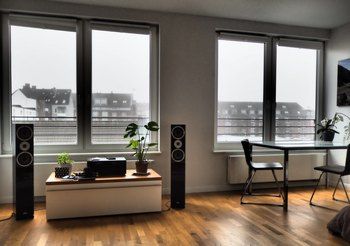
Publisher:
Bonnie King
CONTACT:
Newsroom@Salem-news.com
Advertising:
Adsales@Salem-news.com

~Truth~
~Justice~
~Peace~
TJP
Feb-22-2020 19:48

 TweetFollow @OregonNews
TweetFollow @OregonNews
Innovative Building Design Solutions Fight Indoor Air Pollution
Salem-News.com BusinessBiophilic design incorporates the natural world into indoor environments
 Photo by Roxanne Joncas on Unsplash |
(SALEM, Ore.) - Salem is no stranger to poor outdoor air quality — stagnant air conditions and the third-driest November on record resulted in the Oregon DEQ declaring it a “moderate health concern” in the tail end of 2019.
Although the air quality advisory has since been lifted, Salem residents can now benefit from paying attention to the quality of the air inside their homes.
Most Americans spend 90% of their time indoors, where there’s a higher level of pollutants than outside.
Indoor air pollution is caused by common building materials that emit harmful gases, particles or toxins into the air. Fortunately, now building designers are taking action to maintain healthy indoor air quality.
Low-emitting materials reduce off-gassing
When selecting interior building materials, designers are increasingly looking for affordable, low-maintenance, durable options that promote good indoor air quality.
Paint, sealant, caulking, adhesives, carpet, flooring, ceiling tiles and composite wood products commonly contain harmful chemicals that are gradually released over time even years after installation — a process known as “off-gassing.”
Volatile and semi-volatile organic compounds are two major concerns known to pollute indoor air quality. Exposure to low-levels of VOCs over time has been shown to cause health problems for people with asthma or people particularly sensitive to chemicals. Short-term symptoms include headaches, dizziness, asthma, nausea, and eye, nose and throat irritation.
In the long term, exposure can lead to cancer, liver and kidney damage, and central nervous system damage. Designers are therefore choosing to install non-toxic materials and water-based adhesives and coatings that contain low levels of VOCs. It’s also important to consider materials that are easy to maintain without the use of toxic cleaning products.
Filtration systems purify indoor air
Building designers also consider the impact of outdoor air on indoor air pollution. Air intakes positioned away from sources of pollution (like restaurants, factories, traffic and fires) protect the air coming into the building.
Air filters purify indoor air and remove dust, debris, bacteria, pollutants and allergens that may be carried in from the outside. When left unfiltered, these particles commonly result in allergic reactions, headaches, nausea, coughing fits and sneezing.
Installing effective air filters cleans the air and alleviates symptoms. Advanced filtration systems — such as, MERV 15 or carbon gas filters — are also useful in locations with a problem with particularly poor indoor air conditions caused by severe outdoor pollution. Underfloor air distribution systems are also a better alternative to overhead systems.
They positively impact occupant health and comfort while improving ventilation and indoor air quality. These systems also reduce energy use, making them a more affordable option.
Minimizing air pollution with biophilic design
Used by tech companies like Microsoft, Facebook, Amazon and Google, biophilic design incorporates the natural world into indoor environments to improve occupant health and well-being.
In particular, biophilic design features live greenery to improve air quality, reduce CO2 levels and decrease humidity. In turn, symptoms commonly caused by indoor air pollution (such as, coughing, congestion and irritation to the eyes, nose and throat) are minimized. For example, snake plant (or Mother-in-Law's Tongue) is excellent at filtering chemicals like benzene, formaldehyde, trichloroethylene, xylene and toluene from the air.
Biophilic design also uses natural and eco-friendly materials. Flooring, for example, may be constructed from marble, natural wood or stone, or be laid with wool, sisal and coir carpets. These natural materials don’t emit VOCs and so contribute to healthy indoor air quality.
Indoor air pollution is a serious problem that negatively impacts health and well-being. Low-emitting materials, filtration systems and biophilic design are some of the latest building design solutions helping to maintain fresh and healthy indoor air.
Source: Salem-News.com Special Features Dept.
Articles for February 21, 2020 | Articles for February 22, 2020 | Articles for February 23, 2020
Salem-News.com:



Quick Links
DINING
Willamette UniversityGoudy Commons Cafe
Dine on the Queen
Willamette Queen Sternwheeler
MUST SEE SALEM
Oregon Capitol ToursCapitol History Gateway
Willamette River Ride
Willamette Queen Sternwheeler
Historic Home Tours:
Deepwood Museum
The Bush House
Gaiety Hollow Garden
AUCTIONS - APPRAISALS
Auction Masters & AppraisalsCONSTRUCTION SERVICES
Roofing and ContractingSheridan, Ore.
ONLINE SHOPPING
Special Occasion DressesAdvertise with Salem-News
Contact:AdSales@Salem-News.com

Terms of Service | Privacy Policy
All comments and messages are approved by people and self promotional links or unacceptable comments are denied.
[Return to Top]
©2025 Salem-News.com. All opinions expressed in this article are those of the author and do not necessarily reflect those of Salem-News.com.